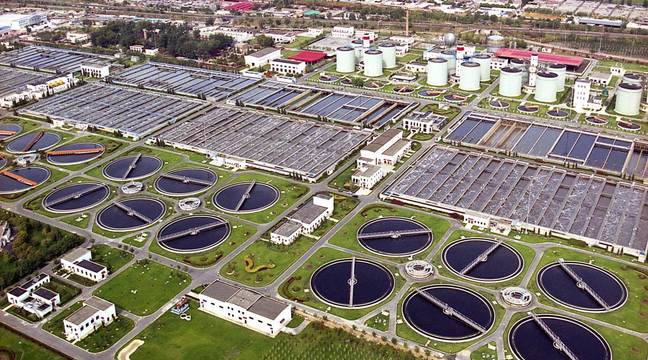
当前课程知识点:Water and Wastewater Treatment Engineering: Biochemical Technology > Chapter 2 Activated sludge process > Section 2.1 Basic concept of activated sludge process > Section 2.1.2 Basic concept of activated sludge process
返回《Water and Wastewater Treatment Engineering: Biochemical Technology》慕课在线视频课程列表
返回《Water and Wastewater Treatment Engineering: Biochemical Technology》慕课在线视频列表
第二个内容,是关于活性污泥的性质,及其性能指标
首先,我们看活性污泥的物理性质
通常活性污泥,我们称为菌胶团,或者说是一种生物絮凝体
从颜色上来看,它一般是黄褐色,或者说是土黄色有的时候在处理一些特殊的工业废水的时候,会呈铁红色
气味通常是一种土腥味
特别是,我们绝大部分的活性污泥工艺都是处理城市污水的时候
它的味道是一种泥土味
它的比重略比水重,粒径是在0.02-0.2mm之间
它的比表面积也很大,通常会在20-100cm2/mL之间
第二个是活性污泥的一些组成
活性污泥中间绝大部分的组成是水
通常活性污泥的含水率是在99.2%-99.8%之间
除了水以外,还有一些固体物质
它的含固率是在0.2%-0.8%
在固体物质中间,主要有两部分组成
一部分是有机物,一部分是无机物
在有机物中间,通常我们又可以把它分成三个组成部分
第一,就是活性的活细胞,我们用Ma来表示
第二部分是微生物内源呼吸代谢的残留物
第三部分是活性污泥吸附的原废水中间难于生物降解的一些有生物
这样两部分呢,分别用Me和Mi来表示
那么无机物呢,我们通常用Mii来表示
在普通的活性污泥中间呢,有机物的含量通常会占到75%-85%之间
第三个,我们要谈的是活性污泥中间的微生物
活性污泥中间的微生物主要有两大类
一大类是一些细菌;另一大类是比细菌要明显大的原生动物或者后生动物
细菌是活性污泥发挥废水净化功能的最活跃的微生物
主要菌种有动胶杆菌、假单胞菌、微球菌、黄杆菌
芽胞杆菌、产碱杆菌、以及无色杆菌等
它们的特征是绝大多数都是好氧或兼性异养型的原核生物
它们在好氧条件下,具有很强地分解废水中有机物的能力
它们都具有很高的增殖速率,它们的世代时间一般是在20-30 min
特别是其中的动胶杆菌具有将其他细菌集结成为”菌胶团"的功能
活性污泥中的原生动物主要有草履虫、盖纤虫、变形虫、钟虫等
它们通常以细菌或废水中的微小有机颗粒为食
其数量大约是每毫升活性污泥中间有1000个
活性污泥中间主要的后生动物有线虫、轮虫等
它们是比原生动物更高等的多细胞动物
它们通常会以原生动物或其他微生物为食
活性污泥中间的原生动物或后生动物的数量、种类
与活性污泥系统的运行状况、废水处理程度等密切相关
因此常被用来作为活性污泥的"指示生物"
这张图说明了活性污泥系统中,随着运行时间的延长
废水中间残留有机物的浓度由高到低变化时
不同种类的原生动物、后生动物出现的先后、数量的多少
可以看到,随着运行时间的延长、废水水质逐渐变好
原生动物从肉足虫类、鞭毛虫类、游泳型纤毛虫类、固着型纤毛虫类而变化
最后才会出现轮虫等后生动物
在介绍了活性污泥的一些基本性质以后
让我们来看活性污泥的性能指标
第一个性能指标是活性污泥的浓度
通常我们称为混合液悬浮固体浓度(MLSS)
由这个公式我们可以看出,MLSS实际上包含了活性污泥中间
前面已经说过的四大类的固体物质,Ma,Me,Mi和Mii
第二个性能指标呢是混合液挥发性悬浮固体浓度(MLVSS)
从这个公式我们可以看出,它实际上包含的是活性污泥中间的三类有机物质
Ma,Me和Mi
在条件一定时,MLVSS比MLSS也就是VSS比SS,它的值是比较稳定的
在处理城市污水的活性污水系统中间,一般这个值在0.75-0.85之间
第三个活性污泥的性能指标是,污泥沉降比(SV)
实际上我们从它的英文Sludge Volume可以看出来
它指的是一个沉淀污泥的体积
它的定义是,将曝气池中间的混合液在量筒中静置30分钟
其中沉淀污泥与原混合液的体积比,一般用百分数来表示
它的功能是能够相对反映活性污泥的浓度或者是污泥的凝聚或者沉降性能
可以用来控制剩余污泥的排放量以及及时地发现早期的污泥膨胀
污泥沉降比的正常范围是在20%-30%之间
从这个图我们可以看出,我们从曝气池中间用一个一升的量筒取出混合液
经过一定时间的沉淀
污泥会跟上清液分离
到30分钟的时候,我们发现沉淀污泥的体积是400ml
所以说明这个污泥的SV就是40%
第4个性能指标是污泥体积指数,简称SVI
它的定义是:曝气池中的混合液经30分钟静沉后
1g干污泥,有时为了特别强调,也称1g绝干污泥
所形成的沉淀污泥,即湿污泥的体积,其单位是ml/g(老师口误)
SVI与前面所说的污泥沉降比SV,他们之间的关系,可以用这个公式来表示
跟SV相比,SVI能更准确地评价污泥的凝聚性能和沉降性能
当它的值非常低的时候,说明活性污泥中间的污泥颗粒比较小
污泥的密度比较大,无机成分可能过高
如果这个值过高,说明它的沉降性能不好
将要或者已经发生了污泥膨胀
在处理城市污水的活性污泥系统中间
SVI的正常值是在50-150ml/g之间
这一节的第三个内容,是关于活性污泥法的基本工艺参数
首先我们来看,曝气池的有机容积负荷
所谓曝气池的有机容积负荷是指一个立方米的反应器体积
在一天里面所承担的或者是所去除的有机物的量
因此,它有不同的表达形式
第一个是从进水的角度来看,我们称为进水的有机容积负荷
可以用COD或者是BOD5来表示
这里给出了不同的计算公式,大家可以去仔细地研究一下
它的单位呢分别是kgCOD/m3.d或者是kgBOD5/m3.d
第二个是去除容积负荷,它的计算公式也在这里给出了
实际上是指这一个立方米的反应器体积在一天里面
所能够去除的COD的量,或者是BOD5的量
第二个工艺参数是曝气池的有机污泥负荷
它同样也分为进水污泥负荷和去除的污泥负荷
它们的计算公式分别如这些公式所示
它们的单位就是kgCOD/kgMLSS.d
或者是kgBOD5/kgMLSS.d,或者是kgBOD5/kgMLVSS.d
它的意思指的是曝气池中间每公斤的污泥在一天里面
所去除或者说是所承受的有机物的量,分别用COD和BOD5来表示
去除的污泥负荷,我们也给出了它的计算公式
单位跟进水污泥负荷的单位是一样的
但是要知道它所表达的kgCOD或者kgBOD5是指
在曝气池中间一天里面去除掉的COD的量或者是BOD5的量
第三个很重要的工艺参数,我们称为水力停留时间,简称为HRT
它最简单的计算公式就是用曝气池的体积除上曝气池每天所处理的污水量
最后要把它换算成用小时来表示
在正常的处理城市污水的活性污泥工艺中间
这个HRT通常会在6h-8h,个别的会延长到15h
第四个工艺参数是曝气池的污泥停留时间,我们也成为SRT
有时候也把它称为污泥龄
指的是活性污泥在曝气池中间的一个平均的停留时间
我们在这给出了污泥停留时间或者污泥龄的计算公式
可以看到,这个分子是V乘上X,是指的曝气池中间的污泥的总量
底下△X是指这个系统中间每天增长的污泥量
中间给出了一个比较复杂的计算公式
考虑到进水中间有可能会带入一定的微生物的量
出水中间还会带出一定的污泥量
如果我们能够假设这两部分的量都很小
就可以直接用最后这个的公式来进行计算
也就是曝气池中间的污泥总量除上由剩余污泥的排放导致的污泥的排放量
其中Xr是指的回流污泥的污泥浓度
它跟SVI的关系可以由这样一个公式来表示
即Xr约等于10的6次方除上SVI,单位就是mg/L
大家可以想一下,为什么会有这样一个结果呢?
我们可以看这样的一个工艺图
这个图给出了整个活性污泥系统的各个重要节点的流量
有机物的量以及污泥的浓度
可以看到在正常的活性污泥工艺中间
它是用二沉池来实现污泥的沉淀,实现泥水分离
保证最后的出水水质
在二沉池中间,是一个动态沉淀过程
进水混合液源源不断地进入二沉池,上清液源源不断地排出
回流污泥源源不断地在回流
如果我们能够假设在前面我们测SVI的这样一个过程
即在一个量筒中间静沉30分钟这样的一个过程
它的沉淀效果等同于二沉池中间连续沉淀的这样的一个效果的话
我们就会发现它的SVI跟Xr的关系就是10^6除上SVI
就可以得到回流污泥的浓度
这节内容就到这儿
-Section 0.1 Development Status of Wastewater Treatment Process
--Section 0.1 Development Status of Wastewater Treatment Process
-Section 0.2 Typical Processes of Wastewater Biological Treatment
--Section 0.2 Typical Processes of Wastewater Biological Treatment
-Section 1.1 Principles of wastewater aerobic biological treatment
--1.1 Principles of wastewater aerobic biological treatment
-Section 1.2 Principles and determination of wastewater biodegradability
--1.2 Principles and determination of wastewater biodegradability
-Section 1.3 Principles of wastewater anaerobic biological treatment
--Section 1.3.1 Principles of wastewater anaerobic biological treatment(1)
--Section 1.3.2 Principles of wastewater anaerobic biological treatment(2)
-Section 1.4 Principles of wastewater biological nitrogen removal
--Section 1.4 Principles of wastewater biological nitrogen removal
-Section 1.5 Principles of wastewater biological phosphorus removal
--Section 1.5 Principles of wastewater biological phosphorus removal
-Chapter 1 Homework
-Section 2.1 Basic concept of activated sludge process
--Section 2.1.1 Basic concept of activated sludge process
--Section 2.1.2 Basic concept of activated sludge process
-Section 2.2 Growth rule of activated sludge and its application
--Section 2.2 Growth rule of activated sludge and its application
-Section 2.3 Running mode of activated sludge process
--Section 2.3.1 Running mode of activated sludge process(1)
--Section 2.3.2 Running mode of activated sludge process(2)
-Section 2.4 Kinetics of active sludge process
--Section 2.4.1 Kinetics of active sludge process(1)
--Section 2.4.2 Kinetics of active sludge process(2)
--Section 2.4.3 Kinetics of active sludge process(3)
--Research and Development of Kinetic Model of Activated Sludge Process
-Section 2.5 Principle, calculation and equipment of aeration
--Section 2.5.1 Principle, calculation and equipment of aeration(1)
--Section 2.5.2 Principle, calculation and equipment of aeration(2)
-Section 2.6 Designing of activated sludge process
--Section 2.6 Designing of activated sludge process
-Section 2.7 Operation and management of active sludge process
--Section 2.7.1 Operation and management of active sludge process (1)
--Section 2.7.2 Operation and management of active sludge process (2)
-Chapter 2 Homework
-Section 3.1 Basic principle of biofilm
--Section 3.1 Basic principle of biofilm
-Section 3.2 Biofilter process
--Section 3.2.1 Biofilter Process (1)
--Section 3.2.2 Biofilter process (2)
--Section 3.2.3 Biofilter process (3)
-Section 3.3 Biodisk process
-Section 3.4 Biological contact oxidation process
--Section 3.4 Biological contact oxidation process
-Section 3.5 Aerobic biological fluidized bed process
--Section 3.5 Aerobic biological fluidized bed process
-Chapter 3 Homework
-Section 4.1 Oxidation ditch process
--Section 4.1 Oxidation ditch process
-Section 4.2 A-B process
-Section 4.3 SBR process
-Section 4.4 MBR process
-Chapter 4 Homework
-Section 5.1 Overview and characteristics of development of anaerobic biological treatment
--Section 5.1 Overview and characteristics of development of anaerobic biological treatment
-Section 5.2 Anaerobic digester
--Section 5.2 Anaerobic digester
-Section 5.3 Anaerobic contact process and anaerobic filter process
--Section 5.3 Anaerobic contact process and anaerobic filter process
-Section 5.4 UASB process
-Section 5.5 Other anaerobic biological treatment process
--Section 5.5 Other anaerobic biological treatment process
-Section 5.6 Operation management of anaerobic biological treatment process
--Section 5.6 Operation management of anaerobic biological treatment process
-Chapter 5 Homework
-Section 6.1 Introduction
-Section 6.2 Biological nitrogen removal process and technology
--Section 6.2 Biological nitrogen removal process and technology
-Section 6.3 Biological phosphorus removal process and technology
--Section 6.3 Biological phosphorus removal process and technology
-Section 6.4 Simultaneous nitrogen and phosphorus removal process
--Section 6.4 Simultaneous nitrogen and phosphorus removal process
-Chapter 6 Homework
-Section 7 Natural biological treatment process
--Section 7 Natural biological treatment process
-Chapter 7 Homework
-Section 8.1 Source, nature and treatment of sludge
--Section 8.1 Source, nature and treatment of sludge
-Section 8.2 Sludge thickening and digestive stability
--Section 8.2 Sludge thickening and digestive stability
-Section 8.3 Sludge conditioning, dehydration and incineration
--Section 8.3 Sludge conditioning, dehydration and incineration
-Chapter 8 Homework
-Section 9 Wastewater Discharge and Reuse
--Section 9 Wastewater Discharge and Reuse
-Chapter 9 Homework

